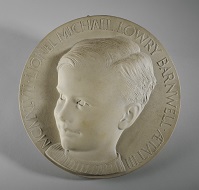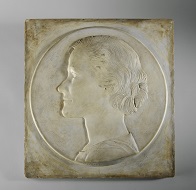October 12, 2017 – The Henry Moore Institute in Leeds presents the special exhibition “Marry Gillick: Her Art in your Pocket”. This display is the first dedicated to Gillick’s sculpture, and presents plaster models, drawings and photographs showing her working processes for the production of coins, medals and portrait reliefs. The exhibition runs through January 28, 2018, at Gallery 4.
Trained as a sculptor at Nottingham School of Art and the Royal College of Art, Mary Gaskell Gillick (née Tutin) (1881-1965) won a competition in 1952 that would see her art in everyone’s pockets: her portrait of Queen Elizabeth II appeared on British and Commonwealth coinage until decimalisation in 1971.
Mary Gillick carving Sir Thomas More for Crosby Hall (1926). Courtesy the Estate of Mary Gillick and Leeds Museums and Galleries (Leeds Art Gallery).
Mary Gillick was born in Nottingham and studied at Nottingham School of Art (1898-1902) before completing her training at the Royal College of Art (1902-04) under the sculptor Édouard Lantéri (1848-1917). She met fellow sculptor Ernest George Gillick (1874-1951) while at Nottingham and they married in 1905, forming what was described in her obituary as ‘an ideal working partnership’ based at their studio and home at Moravian Close in Chelsea from 1914.
Gillick was a regular exhibitor at the Royal Academy of Arts from 1911, with her lead garden sculpture ‘Adam’ being displayed in 1933. A companion piece – ‘Eve’ – was also shown at the Royal Academy and purchased from the exhibition in 1934 by Charles Boot (the entrepreneur behind Pinewood Studios) for his home, Thornbridge Hall in Derbyshire. Although the whereabouts of these two lead sculptures is unknown, the exhibition features plaster casts of both ‘Adam’ and ‘Eve’ lent by the Gillick Estate, which are on display in public for the first time.
Mary Gillick, Medallion Portrait of Queen Elizabeth II (1952). Courtesy the Estate of Ernest and Mary Gillick and Leeds Museums & Galleries (Leeds Art Gallery).
Gillick was well-known during her lifetime for her medallic relief work and for the production of memorial portrait plaques for public buildings, but she is most widely remembered for her portrait of Queen Elizabeth II designed for the obverse of British and Commonwealth coinage. Gillick won the commission from a field of seventeen when she was seventy-one years old, recently bereaved and in poor health.
The commission had to strike a delicate balance between traditional numismatic design and the optimistic post-war spirit of the ‘New Elizabethans’ exemplified by the 1951 “Festival of Britain”. First struck in 1953, her depiction was unconventional because the new monarch was shown uncrowned and truncated at the shoulder in a design that was informed by the early Victorian bun penny and sixteenth-century lettering.
Gillick worked on the portrait between March and October 1952, with one sitting and close supervision by the Duke of Edinburgh. The portrait was first modelled in wax and then cast in plaster, when Gillick began to experiment with the inscription around the edge. With each variation another mould and cast were made until she had refined the design sixty-three times.
“A talented and sensitive sculptress (whose) deeply laid convictions and her training caused her to work in the academic tradition of the west, though she always had sympathy and understanding for what younger artists were doing so long as this was based on technical competence. ”
Mary Gillick, Medallion Portrait of Lionel Michael Lowry Barnwell (1947). Courtesy the Estate of Ernest and Mary Gillick and Leeds Museums & Galleries (Leeds Art Gallery).
The Gillicks were firmly embedded in the world of inter-war and post-war British sculpture, with Sydney Cockerell, Kenneth Clark, Meredith Frampton, Gertrude Hermes, Laura Knight, Eric Kennington, Gilbert Ledward, Alfred Munnings and Charles Wheeler among their friends and acquaintances.
Mary Gillick, Medallion Portrait of Kathleen Ferrier (1958). Courtesy the Estate of Ernest and Mary Gillick and Leeds Museums & Galleries (Leeds Art Gallery).
From the paper silhouettes Gillick made as a sixteen-year-old in 1897, the exhibition follows the trajectory of her career through the portrait commissions of Lionel Michael Lowry Barnwell (1947), Frederic Anstruther Cardew (1950), Queen Elizabeth II (1952) and Kathleen Ferrier (1958) from the Sculpture Collection and Archive of Sculptors’ Papers of Leeds Museums and Galleries.
For more information on the exhibition, go to the website of the Henry Moore Institute.
Further biographical details of Mary Gillick are available at this website.
And a contribution on Mary Gillick as a medallic artist can be read on the The Royal Mint blog.







